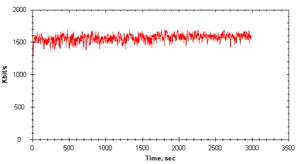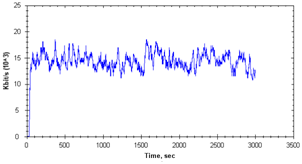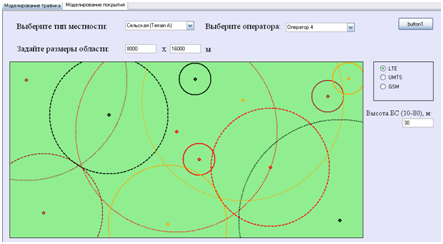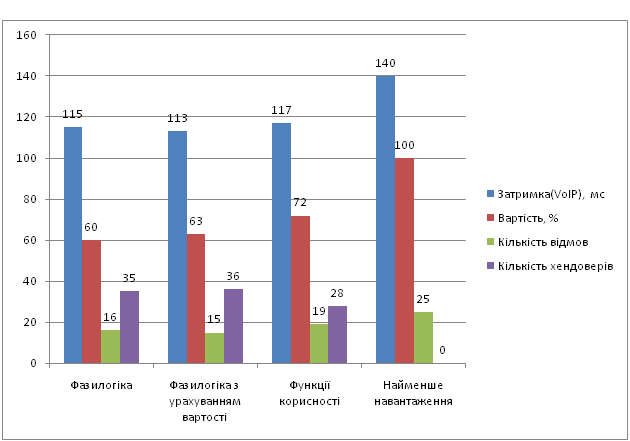Abstract
- The aim and the tasks of the master research work
- Introduction
- 1. The analysis and description of the research subject
- 1.1. The tendencies of the telecommunication networks development
- 2. Developing the criterion of load balancing
- 2.1 Traffic balancing criteria work algorithm requirement
- 2.2 Use function’s based criteria
- 3. Modeling the system developed
- 3.1. Designing an imitative model
- 3.2 Modeling results analysis
- Conclusions
- References
The aim and the tasks of the master research work
Under the present conditions in Ukraine, when the new generation networks of a national scale are developing there arise a number of problems like a limited budget, insufficient frequency resource, absence of the appropriate licenses and certain difficulties in obtaining them, shortage of covering. There still exist places with insufficient or no covering like railway, motorways and small settlements. All these prevent from providing there modern mobile services, which have become not luxury but the necessity.
The aim of this work is to improve the quality of the rendered mobile service through forming and using a converged multiservice telecommunication network based on the new generation technologies.
Introduction
The mobile operator’s market in Ukraine is represented by different generation technologies – 2G (GSM), 3G (UMTS, CDMA2000), 4G (WiMAX). The 2G network covering embraces almost the whole territory of the country, however it cannot provide the appropriate quality level and range of services the demand for which is constantly growing (VoIP, IPTV, VoD, videoconference and so on). While city residents are provided with high speed Internet both through wire and wireless technologies, country residents and long distance transport passengers have no access to telecommunication services in full range. Thus there arises a necessity to move to new generation technologies which can meet these requirements in national scale. The solution to this problem is of great social importance became infocommunication services in modern world is not a luxury but the necessity.
1 THE ANALYSIS AND DESCRIPTION OF THE RESEARCH SUBJECT
1.1 The tendencies of the telecommunication networks development
Growing user’s demand for mobile services at any time or place, leads to rapid technologic development towards the integration of different wireless access technologies. Such integration unites different networks in a single system which is called the Fourth Generation of the wireless networks. The 4G networks will provide significantly higher speeds for data transmissions, offer a wide range of different applications, unavailable before because of the limited traffic bandwidth, and allow global roaming between mobile networks with different access technologies.
It is planned that there will be the following scenario in 4G by default, a telephone or a mobile terminal with a few interfaces will have a possibility to choose the most suitable access channel from the available alternatives. These access channels include IEEE 802.11 Wireless Local Area Network (WLAN) access IEEE 802.16 Worldwide Interoperability for Microwave Access (WiMAX), satellite systems and 4G LTE in addition to traditional mobile cell networks. For satisfactory cooperation with the user the mobile terminal must easily choose the best
access channel from available alternatives and address or readdress the traffic to it without interrupting the conversation or the video. Such access possibility is called Always On, Always Best Connected
.
2 DEVELOPING THE CRITERION OF LOAD BALANCING
2.1 Traffic balancing criteria work algorithm requirement
The object of developing is the criteria of the traffic balancing in convergent network which will support and realize the multi homing technology and vertical handover. It is realized as a complex criterion, describing the quality of a management decision. The set of parameters to be taken into consideration includes: traffic type, QoS parameters (band width, delay, jitter, packet losses), mobile unit parameters (speed, location, network interfaces available, battery’s condition), user’s preferences, costs, handover coefficient etc.
In most part of modern algorithms while solving the task of optimal traffic balancing the free resources of the network are used as criteria. It means that the requirements that have just been required are sent in the network together with the free resources themselves. Its disadvantage is that the network service quality parameters and its tariffs, are not counted in this case.
2.2 Use function’s based criteria
A recently developed criterion, based on the use functions which represent the dependence of quantitative standardized value from a certain QoS link parameter and are determined as the limit of each of the parameters and certain traffic type sensitivity to the parameter changes [1]:
where U(x) is the x parameter use function; i is the number of a candidate network; j is the traffic type; b – bandwidth; L – packet losses; Ñ – a data unit cost in the network; w1 and w2 – weight coefficients of QoS and cost parameters correspondently, defined by the operators policy (by default w1 = w2 = 1).
Let’s consider, for example, the use functions for VoIP traffic in details. For traffic capacity the function will look as follows:

With its help we can obtain graphic dependence, which will look as follows:

Picture 2.1 – The use function for traffic capacity
It can be seen that the function has a leap like character, if the network provides the necessary traffic capacity (more than 0.06 Mb/s), then the function takes meaning 1, if not the function equals 0.
Next we shall consider the use function for the delay, in this case graphic dependence has a different look, the bigger the delay is the smaller the use functions meaning becomes according to the exponent:


Picture 2.2 – Use function delay for VoIP traffic
The jitter use function for VoIP traffic looks similar to delay:


Picture 2.3 – Use function jitter for VoIP traffic
The dependence shows that after jitter meaning equals 20 ms, the use function meaning decreases rapidly. And the last use function, the losses, looks as follows:

Picture 2.4 – Use function losses for VoIP traffic
The difficulty in forming the criteria is to determine the use function parameters and weight coefficients. Network users value the quality of services not for QoS parameters figure meaning but for subjective appraisal.
3 MODELING THE SYSTEM DEVELOPED
3.1. Designing an imitative model
Modeling the work of suggested device has been done in conditions of heterogenic environment of a virtual operator, composed of five operators (it can be UMTS, LTE, GSM) based on the three above mentioned criteria in C# packet. The imitation model structure consists of a traffic generator, networks parameters generator and a decision making block (see pic. 3.1)

Picture 3.1 – The imitation's model scheme
To imitate receiving calls into user’s network a traffic generator must be designed. To do this one should review the main types of traffic in the modern multiservice mobile networks and analyze the laws of distribution function characteristic for these traffic types.
The main sources of traffic in modern multiservice networks are VoIP (voice over IP), HTTP (Hyper Text Transfer Protocol) and IPTV(UDP protocol). Research shows that for VoIP traffic conversation lengths sequence has the exponential distribution and the intervals sequence between calls has the same kind distribution. For IPTV traffic the service time is also divided under the exponential law and the period between the calls is described according to Pareto. The HTTP traffic has a distributed under the lognormal law period between the calls and distributed under the exponential law calls service time.
The process of receiving calls is modeled as a recurrent, where the moment of the next call incoming is calculated by adding the random time interval to the previous one. Random intervals between calls z_i for VoIP traffic inquiries are formed at the exponential distribution with the flow parameter. For this one must for every random number ri (0, 1), which is generated by a pseudorandom numbers sensor solve the equation:
Solving this equation towards zi we get:
The i-th call time service is distributed at the exponential law:
where hi is the average time of the i-th call servicing, r is the random number equally distributed at the period [0,1].
For modeling receiving and servicing IPTV inquiries random intervals between calls are formed at Pareto distribution, which is obtained while modeling through moving from equal distribution by reverse functions method:[2]

Where zi is the i-th time period between calls, α is the form distribution parameter; b – distribution mode, r is an random number equally distributed on the period [0,1].
The service time of i-th call for IPTV traffic is also distributed at exponential law and is calculated under the formula 1.1. To generate the random periods between the HTTP traffic inquiries, distributed at lognormal law, a connection with normal distribution, is used. To do this we generate a normally distributed random value ri with mathematical expectation 0 and dispersion 1 and move on to value ξi distributed normally with mathematical expectation μ and standard deviation σ, after which its exponent is calculated:
The service time for i-th call of HTTP traffic is distributed at exponential law and is modeled on the formula 1.1.
In this way a flow of inquiries from any number of subscribers at any period of time can be generated. Also, the possibility of choosing the codec type for VoIP inquiries and choosing the MPEG-4 codec parameters for IPTV traffic is realized. Picture 3.2 shows the program interface with traffic calculation realizing:

Picture 3.2 – The traffic calculation program interface
With the help of the developed program we obtain the loading graphs (pic 3.3, 3.4, 3.5) with the following modeling parameters modeling time 3000 seconds, subscribers quantity 70, VoIP traffic (traffic parameter 5 call/min., the average service time 120 sec, codec G.726-24), IPTV traffic (traffic parameter 2 call/min., the average service time 180 sec , codec H.264-352x288), HTTP traffic (traffic parameter 10 call/min., the average service time 5 sec).

Picture 3.3 – VoIP loading traffic

Picture 3.4 – IPTV loading traffic

Picture 3.5 – HTTP loading traffic
The next step is modeling the mobile network covering. To calculate the base stations (BS) covering LTE UMTS, WiMAX and CDMA technologies the Stanford University Interim (SUI) was used [3]. It allows calculating the BS signal fading to mobile terminal (MT) for different landscape types (country, suburban, urban) for frequencies from 2 HHz on the following formula:
where ![]() =100 m, d is the distance between BS and MT in meters
=100 m, d is the distance between BS and MT in meters
Correction factor for BS height ![]() , S is shadowing,is the path loss component and it is described as:
, S is shadowing,is the path loss component and it is described as:
where ![]() is the height of the base station and
is the height of the base station and ![]() are the terrain type coefficients.
are the terrain type coefficients.
where ![]() is free space path loss while do is the distance between Tx and Rx,
is free space path loss while do is the distance between Tx and Rx, ![]() is the wave length. The correction factor for frequency and base station height are as follows:
is the wave length. The correction factor for frequency and base station height are as follows:
where ![]() the frequency in MHz,and
the frequency in MHz,and ![]() is the height of the receiver antenna. These expressions are true for country and suburban terrain. For urban conditions the following formula is used:
is the height of the receiver antenna. These expressions are true for country and suburban terrain. For urban conditions the following formula is used:
where α=5,2 dB for rural and suburban environments and α=5,2 dB urban environment.
The program was made on the basis of the above mentioned formula and it allow choosing one of the three types of terrain, set the plot size in meters and place the BS of different technologies on the territory. While choosing the BS it is necessary to state the antenna put up height and locate it on the territory, the program draws the covering radius for this BS. The program interface is represented on picture 3.6.

Picture 3.6 – The cover calculation program interface
In this way we obtain the map of covering and receiving requirements from the subscribers moving on this map. The next step is to distribute these requirements into different networks.
3.2 Modeling results analysis
As result of modeling we obtain the out coming values vector( see pic 3.1) which consists of relative general service cost for subscribers while modeling Ñab, the number of refusals (or lost calls) and one of the quality parameters the average VoIP traffic delay. Also, as a result of the imitative model operating we evaluated the quality characteristics to manage the data traffic: the smallest loading criterion, the use function criterion, fuzzy criterion involving QoS and fuzzy criterion involving QoS and the cost.
Picture 3.9 shows the diagrams reflecting the network operation quality using different criteria to distribute traffic into networks.

Picture 3.9 – Modeling results
Conclusions
As a result of performing the work solutions to improve the quality of mobile networks subscriber service in conditions of heterogenic multi operator space have been suggested. The work offers the analysis for 3-d and 4-th generations networks developing prerequisites. It shows that organizing such networks in national scale is impossible if only one operator’s resources are used. A special problem is covering rail and motor ways as well as comparatively density population settlements. It makes the mobile operators unite to solve the mentioned problems together. We suggest using virtual operator model of the third level. It allows the operators to use common radio subsystem and keep independence and competitiveness.
When writing the abstract of the master's work is not yet complete. Final completion: December, 2013. The full text of the work and materials on the topic can be obtained from the author or his scientific adviser after that date.
References
- Cao Z., Zegura E. Utility Max-Min: An Application-Oriented Bandwidth Allocation Scheme, // Proc. IEEE INFOCOM'99, March - 1999.
- Áåññàðàá Â.È., Èãíàòåíêî Å. Ã.,×åðâèíñêèé Â. Â. Ãåíåðàòîð ñàìîïîäîáíîãî òðàôèêà äëÿ ìîäåëåé èíôîðìàöèîííûõ ñåòåé. // Íàóêîâ³ ïðàö³ Äîíåöüêîãî íàö³îíàëüíîãî òåõí³÷íîãî óí³âåðñèòåòó. Ñåð³ÿ: Îá÷èñëþâàëüíà òåõí³êà òà àâòîìàòèçàö³ÿ. Âèïóñê 15 (130). – Äîíåöüê-2008. – 214 ñ. Ñ. 23-29.
- Noman Shabbir, Muhammad T. Sadiq, Hasnain Kashif, Rizwan Ullah, “Comparison of radio propagation models for long term evolution (lte) network”// International Journal of Next-Generation Networks (IJNGN) Vol.3, No.3, September 2011.
